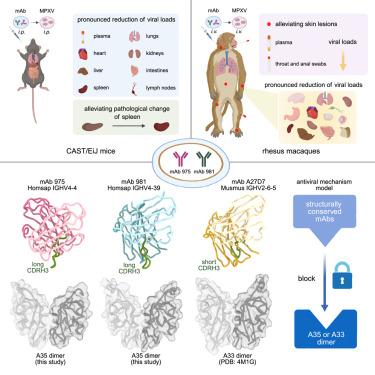Structurally conserved human anti-A35 antibodies protect mice and macaques from mpox virus infection
IF 42.5
1区 生物学
Q1 BIOCHEMISTRY & MOLECULAR BIOLOGY
引用次数: 0
Abstract
The A35 protein, expressed on the enveloped virion of monkeypox (mpox) virus (MPXV), is essential for viral infection and spread within the host, making it an effective antiviral target. In this study, we demonstrated two human anti-A35 monoclonal antibodies (mAbs) displayed potential protection against MPXV in CAST/EiJ mice and rhesus macaques. Using cryo-electron microscopy, we determined two high-resolution structures of the A35 dimer in complex with the fragment of antigen binding of mAb 975 or mAb 981, revealing detailed interactions at the antigen-antibody interfaces. Structural analysis showed that these structurally conserved mAbs bind to a groove region at the interface of A35 dimer. Overall, we provided a proof of concept for a single administration of anti-A35 mAbs mitigating the pathogenic effects of MPXV infection in rhesus macaques. These human-derived mAbs could be served as antibody drug candidates, and their binding models to the A35 dimer will provide valuable insights for future vaccine design.

结构保守的人抗a35抗体保护小鼠和猕猴免受痘病毒感染
A35蛋白在猴痘病毒(MPXV)的包膜病毒粒子上表达,是病毒在宿主内感染和传播所必需的,使其成为有效的抗病毒靶点。在这项研究中,我们证明了两种人抗a35单克隆抗体(mab)在CAST/EiJ小鼠和恒河猴中显示出对MPXV的潜在保护作用。利用低温电子显微镜,我们确定了A35二聚体与mAb 975或mAb 981抗原结合片段复合物的两个高分辨率结构,揭示了抗原-抗体界面的详细相互作用。结构分析表明,这些结构保守的单抗结合到A35二聚体界面的凹槽区。总之,我们为单次给药抗a35单抗减轻恒河猴MPXV感染的致病作用提供了概念证明。这些人类来源的单克隆抗体可以作为候选抗体,它们与A35二聚体的结合模型将为未来的疫苗设计提供有价值的见解。
本文章由计算机程序翻译,如有差异,请以英文原文为准。
求助全文
约1分钟内获得全文
求助全文
来源期刊

Cell
生物-生化与分子生物学
CiteScore
110.00
自引率
0.80%
发文量
396
审稿时长
2 months
期刊介绍:
Cells is an international, peer-reviewed, open access journal that focuses on cell biology, molecular biology, and biophysics. It is affiliated with several societies, including the Spanish Society for Biochemistry and Molecular Biology (SEBBM), Nordic Autophagy Society (NAS), Spanish Society of Hematology and Hemotherapy (SEHH), and Society for Regenerative Medicine (Russian Federation) (RPO).
The journal publishes research findings of significant importance in various areas of experimental biology, such as cell biology, molecular biology, neuroscience, immunology, virology, microbiology, cancer, human genetics, systems biology, signaling, and disease mechanisms and therapeutics. The primary criterion for considering papers is whether the results contribute to significant conceptual advances or raise thought-provoking questions and hypotheses related to interesting and important biological inquiries.
In addition to primary research articles presented in four formats, Cells also features review and opinion articles in its "leading edge" section, discussing recent research advancements and topics of interest to its wide readership.
 求助内容:
求助内容: 应助结果提醒方式:
应助结果提醒方式:


